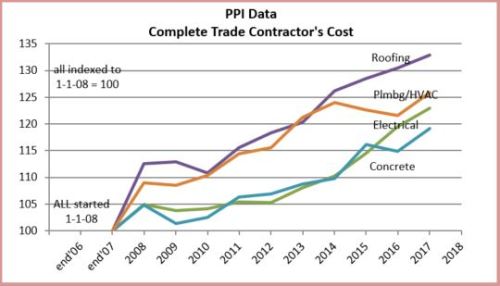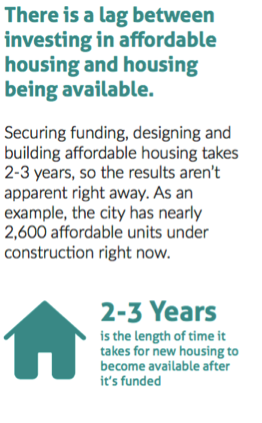Just One More Thing: Even if Jobs Tax Did What it is Supposed to do, it Wouldn’t Solve Housing Problem
I hate to be such a bother, but there’s a few things about this proposed jobs tax that bother me. Maybe you can help answer these questions.
So here’s the City of Seattle’s logic on why they need to tax jobs in Seattle. Their proposed tax would charge businesses $75,000,000 million dollars a year based on the number of employees they have. That money, they say, is set aside to solve homelessness.
However, the number stated by Councilmember Lorena Gonzalez as a rationale for this tax is the 29,000 households she and the City claim are cost-burdened, that is, households paying as much as half their income on housing. Nowhere is there a clear statement of where this number comes from, but one can guess that it comes from 2015 documents the City created using US Census data from earlier.
The next part of the City’s proposal is that roughly 75 percent of the of the $75,000,000 will go toward subsidized non-profit housing, about $57,000,000 per year. The City says that they will support the construction of 1,780 units of housing over 5 years or 356 units per year; that’s about $160,000 per unit.
Then, in a series of non-sequiturs, the City suggests that there are about 2,580 units in production which when added to existing presumably occupied non-profit subsidized units, the total number of units of subsidized housing will be 15,000 units citywide. Then the City says that the regional need is 140,000 units. There is no reference or note as to where these numbers come from or relate with the 29,000 households, the ones “with the greatest barriers to housing.”
So, taking a look at these numbers the key questions are:
How much will the 356 units cost per year total?– An analysis we completed of 8 years of housing created in Seattle using Housing Trust Fund dollarsfound that the cost in 2016 for a unit of housing was about $325,000 per unit. Using division, the cost per unit under the jobs tax would have to be more like $160,000 per unit at a constant over 5 years. Is it possible to build units for that much over the next 5 years?
If there is other money being put forward where is it coming from? And what happens if costs go up as they did between 2008 and 2016, the years of our look at housing costs?The increase in those costs was 43 percent. The Producer Price Index (PPI) has been rising, with building materials rising dramatically.
Is the City’s goal to eliminate the cost burden of the 29,000 people Councilmember Gonzalez references? If it is, then the $57,000,000 per year over 5 years would only create a small dent in that problem, dropping that number, in 5 years, to 27,220. If we include the suggested 2,580 in production now, that number could go down to 24,640 households, if that number stays constant over 5 years.
In the City’s one pager, however, they defend the lack of progress on housing affordability suggesting that housing takes time to build. Here’s their graphic:
So, has the City figured out how they are going to speed that process up? If the first money collected in 2019, then the first units of housing wouldn’t be available until 2022? So the cost burdened households will have to wait until then to get housing? How can families struggling to pay rent next month be sure they can hang on until then? Can they apply for this housing now?
On top of this, the City’s one pager says there are over 8,500 people in Seattle who are homeless. Are these people eligible for the housing? In that case, the actual number the City should be using to establish the need is more like 37,500 households, isn’t it?
Our look at non-profit housing production found that about 300 units were created each year between 2008 and 2016, for a total, over 8 years of about 2,400 units at a total cost of about $600,000,000 or about $250,000 per unit. If the City thinks it’s going to “leverage” other dollars, won’t that add to the production lag of the 3 years that they describe in the one pager?How do they plan to increase historic production by two or three times?
Assuming a doubling of that rate of production from all sources of funding, and a cost of $160,000, over five years about 3,000 units could be created at a cost of $480,000,000 or $96,000,000 per year. Does the City expect funding from other sources in the amount of about $40,000,000 per year?Where is that money coming from? Is it set aside? I thought tax credits were dropping by 14 percent, right?
Based on the City’s assumptions in its Mandatory Housing Affordability (MHA) program, the City will collect and grant out about $472,000,000 from MHA fees to produce 6,320 units of housing by 2025, about 1,264 units per year. Is there any overlap between these units and the units being funded by the tax on jobs? How many?
| MHA | Cost per Year | Jobs Tax | Cost per Year | |
| 2019 | 1000 | $78,666,667 | 356 | $57,000,000 |
| 2020 | 1000 | $78,666,667 | 356 | $57,000,000 |
| 2021 | 1000 | $78,666,667 | 356 | $57,000,000 |
| 2022 | 1000 | $78,666,667 | 356 | $57,000,000 |
| 2023 | 1000 | $78,666,667 | 356 | $57,000,000 |
| 2024 | 1000 | $78,666,667 | 356 | $57,000,000 |
| 6000 | $472,000,000 | 2136 | $342,000,000 |
If we align the two programs over a five year period, assume a production cost of about $100,000 per unit, and that the housing could be delivered almost immediately, the two programs together could have housed almost all of the 8,500 people sleeping outdoors tonight by 2024 at a cost of about $814,000,000. This would require a production of 1,627 units per year over that period and it would assume constant costs and a steady population of need. That’s an increase of about 5 times the rate of production between 2008 and 2016; is that possible to do?
If the programs are intended to overlap, then the number of units would be less than this and would obviously house fewer people over the period at a higher cost per unit. Is it the City’s plan to subsidize the acquisition of land, financing and construction at this pace between now and 2025? Is this even feasible? And if it is, is the City satisfied that it will have reduced the measured problem from 37,500 households down to 29,364 by 2024? Is that their goal? What is their measure of success? And doesn’t this scheme assume a constant need?
And what do people in those 37,500 households do while all this housing is being built? Wouldn’t it just be better to help people with a few hundred dollars in rent money, now?
Sorry for all the bother.




